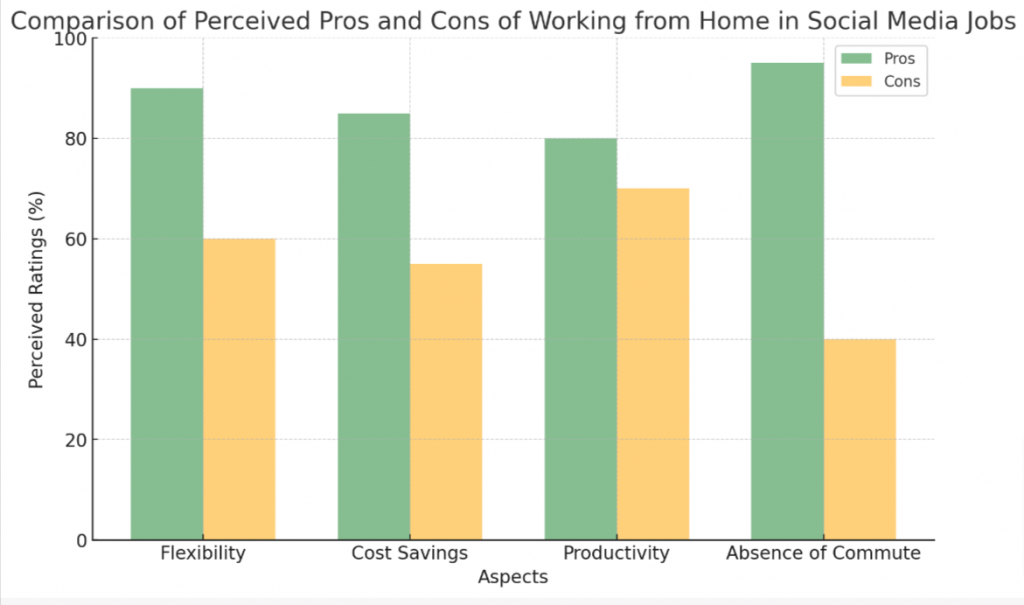Balancing Remote and Office Work: Insights from the Social Media Realm
Choosing between working from home or in an office can be a tricky decision, leaving many unsure about the best path. Interestingly enough, 12.7% of full-time employees are now embracing their homes as their primary workspace, thanks to growing acceptance of remote work environments.
This blog post aims to dissect this debate through the lens of social media, examining how popular platforms illuminate the pros and cons associated with each arrangement. Stay tuned; it’s time to dive into all aspects and let social media guide us on this complex journey.
Key Takeaways
- 12.7% of full – time employees are now working from home, thanks to the growing acceptance of remote work environments.
- Social media platforms like Instagram showcase the freedom and flexibility of remote work through popular hashtags like #workfromanywhere and #remoteworklife.
- Communication habits have evolved with remote work, as employees increasingly use digital platforms such as Snapchat and LinkedIn for workplace interaction and collaboration.
- Workspace flexibility allows remote workers to choose where and when they work, leading to a better work-life balance but also presenting challenges in separating professional and personal spaces at home.
- Both office environments and home environments have their unique benefits and drawbacks, such as providing structured workspace versus offering comfort and flexibility.
- Working remotely can lead to reduced distractions, increased productivity (by up to 13%), and the ability to create an optimal working environment at home.
- Collaboration is possible in both remote settings (through communication tools like video conferencing) and office-based settings (via traditional meetings), with a growing demand for collaboration among distributed teams seen on job postings mentioning “remote work.”
- Effective management practices are crucial in both remote work setups (fostering trust, clear communication, using digital tools) and office environments (creating positive work culture).
- Social media provides insights into the advantages/disadvantages of each option while influencing perspectives on productivity, collaboration, and overall job satisfaction.
Comparison of Working from Home and Working in an Office
Working from home offers the perk of no commuting, while working in an office requires daily travel to and from work.

Commuting Perks
Working from home eliminates the hassle of daily commuting. No more getting stuck in traffic, missing trains, or rushing to catch buses. This seemingly small perk often translates into significant time savings for employees.
With saved time from commuting, individuals can invest it into work productivity or personal activities they love like reading a book or spending quality time with family before knuckling down to work.
An individual working remotely also saves money on fuel costs and public transportation fares. It’s this level of flexibility that makes remote work so appealing to many people today.
Telecommuting means you have no geographic restrictions when choosing your ideal workplace—whether it’s a trendy coffee shop in town, a quiet corner at home, or even that dream vacation spot halfway around the globe! Every day could be #workfromanywhere day and social media platforms like Instagram are full of inspiring photos showcasing such digital nomad lifestyles.
As professionals discover unique ways to redefine their office spaces outside traditional boundaries and share them online proudly under popular hashtags like #digitalnomads and #remoteworklife!
For those who’ve made the switch from office to remote work during the pandemic period as per data shown in LinkedIn, many appreciated these commuting perks which essentially helped improve their overall lifestyle without compromising on professional commitments.
However intriguing it is not clear cut for everyone – some may miss interaction with coworkers leading up to fewer ideas or developmental conversations essential for growth within an organization while others may thrive alone achieving better focus without distractions typically present at an office set-up.
One thing is certain: commute-free working appears here for keeps! The growing adoption rate by companies worldwide indicates teleworking trend isn’t fading anytime soon thanks largely due its prime benefits boosting both employee wellness along with solid potential attracting talent across borders unrestricted by location constraints thus aiding company’s expansion too.
It’s truly remarkable capability brought forth by modern technology enabling us turn any place into our workspace foundationally changing how we view conventional offices forever.
Indeed, digital flexibility brings new life into careers by breaking free traditional office boundaries. Furthermore, it’s drastically cut down on transportation pollution providing an eco-friendly solution aligning perfectly with current ‘Go Green’ initiative which in itself is a great bonus! So next time you’re sipping coffee from your home while working and appreciate the comfortable environment – remember that you’re also contributing towards cleaner greener Earth.
Communication Habits
With the rise of remote work, communication habits have evolved significantly. Employees are increasingly leveraging digital platforms to connect with their peers and superiors. Snapchat, LinkedIn, and other social media applications are becoming indispensable tools for workplace interaction and collaboration.
They enable asynchronous communication that is crucial for teams spread across different time zones.
However, these changes have also created a “telework disparity.” Professionals adept at using social media may find it easier to adapt to remote work settings than those less familiar with these platforms.
Moreover, women appear more positive towards working from home due to altered work styles and lesser hours compared to men. Recognizing these differing attitudes can guide companies in implementing effective WFH policies.
Workspace Flexibility
Workspace flexibility has emerged as a key advantage of work-from-home policies. It refers to the freedom that remote workers enjoy in choosing where and when they work, ranging from their kitchen table to cozy coffee shops or even foreign countries.

This can lead to a better work-life balance by allowing individuals to align their job duties with personal commitments more easily than traditional office-based roles permit. LinkedIn data reveals an increase in job postings offering this perk, indicating the rising demand for flexible working arrangements.
However, workspace flexibility also presents challenges such as difficulty separating professional and personal spaces at home.
Office Environment vs. Home Environment
The office environment and the home environment each have their unique benefits and drawbacks. Let’s compare the two.
| Office Environment | Home Environment |
|---|---|
| Provides a professional setting and structured workspace. | Offers flexibility and comfort, allowing employees to personalize their workspace. |
| Often promotes better collaboration and communication due to physical proximity. | May present communication challenges, but provides opportunities for using various digital communication tools. |
| Can potentially lead to longer work hours due to social pressures and the lack of a physical boundary between work and personal life. | Offers a better work-life balance with reduced work hours, especially appreciated by women, as per the report. |
| May require commuting costs and time. | Eliminates commuting, saving time and money. |
| Can potentially lead to distractions from office politics and noise. | May have distractions from household chores and family members, but also provides an opportunity for better focus in a controlled environment. |
It’s clear that both environments have their pros and cons and the choice between them should be made based on individual circumstances and preferences. The rise in job postings mentioning remote work on LinkedIn signals a shift towards more flexible work arrangements in the changing workforce landscape.
Financial Costs
Working from home or from an office each comes with its own financial implications. Below is a comparative analysis of the financial costs associated with both.
| Working from Home | Working in an Office | |
|---|---|---|
| Commute Costs | Minimal to none as there is no daily commuting. | Commuting costs can be significant, including public transportation, parking, gas, and vehicle wear and tear. |
| Office Space | Home office setup can be expensive initially, but typically is a one-time cost. | Office rental can be a substantial monthly expense for businesses. |
| Utilities | Electricity, internet, and heating costs may increase. | Usually covered by the employer. |
| Food and Drinks | More control over food expenses as you can prepare your meals at home. | Buying lunch every day can add up. Some companies provide free coffee and snacks. |
| Clothing & Laundry | Potentially lower costs due to less need for professional attire. | Professional attire and its maintenance can be costly. |
Important to note, the financial costs of working in an office or from home depend on various factors and can vary greatly from person to person. For instance, according to remote work statistics, 12.7% of full-time employees currently work from home, potentially due to the financial benefits and other perks of remote work.
Furthermore, job postings mentioning remote work have seen a significant increase between January 2020 and March 2022, as per LinkedIn data, indicating a rise in demand for remote work opportunities.
While working from home may save in some areas, it can also lead to higher expenses in others. As such, it’s crucial to make a holistic evaluation of the financial costs before deciding on the best work setup.
Productivity
Remote work has been shown to have a positive impact on productivity. According to studies, remote workers tend to be more productive due to reduced distractions and the ability to customize their workspace.
In fact, a survey conducted by Stanford University found that remote employees experienced a 13% increase in productivity compared to their office counterparts. This boost in productivity can be attributed to factors such as fewer interruptions from colleagues, less time spent commuting, and the ability to create an optimal working environment at home.
Furthermore, technological advancements and access to collaborative tools make it easier for remote workers to stay organized and collaborate effectively with their team members. As companies continue to embrace flexible work arrangements, maximizing productivity in both remote and office settings remains a key focus for organizations seeking success in today’s digital age.
– Collaboration
Collaboration is an essential aspect of any work environment, whether it be remote or office-based. While some may assume that collaboration is hindered in remote settings due to physical distance, research suggests otherwise.
Remote teams are finding innovative ways to collaborate using various communication tools such as video conferencing platforms and project management software. In fact, data from LinkedIn shows that job postings mentioning “remote work” have increased significantly over the past couple of years, indicating a growing demand for collaboration among distributed teams.
Management
Effective management plays a crucial role in determining the success of remote work or office environments. Managers must adapt their leadership styles to accommodate the unique challenges and opportunities presented in each setting.
In a remote work setup, managers need to foster trust and clear communication with their team members, leveraging digital tools and platforms to facilitate collaboration and provide support.
On the other hand, in an office environment, managers focus on creating a positive work culture, promoting teamwork, and addressing any issues that may arise within the physical workspace.
Social Media Perspectives on Working from Home vs. Office
Discover how social media platforms are shaping the remote work vs office debate and gain insights from real-life experiences and opinions. Get a deeper understanding of the advantages and disadvantages of each work setting through a social media perspective.
Observational Study Results
Observational study results provide insights into how remote work and office environments are perceived on social media. These studies analyze trends in social media posts and interactions to gauge the overall sentiment towards working from home versus working in an office.
They reveal that opinions vary widely, with some individuals praising the flexibility and improved work-life balance of remote work, while others express feelings of isolation and a longing for face-to-face interaction.
Additionally, these studies shed light on productivity levels, showing that some employees thrive in a remote setting while others struggle to maintain focus outside of an office environment.
Opinions and Experiences
Social media provides a platform for individuals to share their opinions and experiences on working from home versus working in an office. People have different perspectives based on their personal circumstances and preferences. Here are some insights shared on social media:
- Some individuals express their love for the flexibility of working from home, as it allows them to set their own schedule and work at their own pace.
- Others highlight the benefits of office work, such as the structure it provides and the ability to separate work from home life.
- Many people appreciate the lack of commuting when working from home, as it saves time and reduces stress.
- On the other hand, some individuals miss the daily interactions with colleagues that come with working in an office environment.
- Some remote workers mention feeling a sense of isolation and struggle to maintain work – life balance.
- Several employees value the increased productivity they experience while working from home due to fewer distractions.
- However, others find it challenging to stay focused without the accountability provided by being in an office setting.
Impact of Remote Work on Collaboration and Communication
Remote work has significantly impacted collaboration and communication, leading to changes in collaboration networks and the use of communication media. Read on to explore how social media platforms have shaped the remote work versus office debate and the role they play in maintaining connections among remote workers.
Effects on Collaboration Networks
Remote work has had a significant impact on collaboration networks within organizations. With employees working from different locations, the traditional face-to-face interactions that foster teamwork and innovation have been disrupted.
Instead, collaboration is now heavily reliant on digital platforms and tools. This shift has both positive and negative effects on collaboration networks. On one hand, remote work allows for more flexibility in terms of time zones and geographical distances, enabling teams to collaborate globally.
Additionally, asynchronous communication methods like email and project management software allow team members to contribute ideas and feedback at their own pace. On the other hand, the lack of physical presence can lead to miscommunication or misinterpretation of messages.
Use of Communication Media
Social media platforms have played a significant role in shaping the remote work vs. office debate, particularly in terms of communication. Remote workers and office employees alike utilize various communication tools to stay connected and collaborate effectively.

From video conferencing platforms like Zoom and Microsoft Teams to instant messaging apps like Slack and WhatsApp, these digital tools have become essential for staying connected within teams and across departments.
The use of asynchronous communication allows individuals to reach out at their convenience, while social media platforms provide opportunities for sharing ideas, insights, and updates on projects.
Leveraging social media for team building has also gained prominence, with virtual happy hours, online forums, and shared interest groups becoming popular ways to foster engagement among remote workers.
Firm-wide Remote Work
A growing trend in the workforce is the adoption of firm-wide remote work policies. This means that entire companies or organizations are allowing their employees to work remotely on a full-time or part-time basis.
Remote work options have become more prevalent, with statistics showing that 12.7% of full-time employees currently work from home. Executives and employees alike are leveraging social media platforms to connect with colleagues, collaborate on projects, and stay engaged in virtual team-building activities.
However, while working remotely offers flexibility, better work-life balance, and increased productivity for some individuals, it also presents challenges in terms of collaboration and communication within teams.

Conclusion
Social media has become a powerful platform for discussing the work-from-home versus office debate. Through observational studies and personal experiences shared online, we gain insights into the advantages and disadvantages of each option.
As remote work becomes more normalized, it is important to consider how social media influences our perspectives on productivity, collaboration, and overall job satisfaction.

